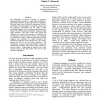Free Online Productivity Tools
i2Speak
i2Symbol
i2OCR
iTex2Img
iWeb2Print
iWeb2Shot
i2Type
iPdf2Split
iPdf2Merge
i2Bopomofo
i2Arabic
i2Style
i2Image
i2PDF
iLatex2Rtf
Sci2ools
FLAIRS
2003
2003
Bayesian Classification of Triage Diagnoses for the Early Detection of Epidemics
The distribution of illnesses reported by emergency departments from hospitals in a region under surveillance is particularly informative for the early detection of epidemics. The most direct source of data for construction of such a distribution is the final diagnoses of patients being seen in the emergency departments, but the delay in their availability impinges on the requirement that detection be timely. Free-text descriptions of patients’ symptoms, called triage diagnoses, and ICD-9 values that encode the symptoms are entered when patients are admitted and, consequently, are timelier sources of data. An experiment to evaluate the accuracy of Bayesian classification of triage diagnoses into syndromes (i.e., illness categories) was performed, resulting in areas under the ROC curve (AUC) between .80 and .97 for the various syndromes. The classification accuracies using triage diagnoses surpass the classification accuracies using ICD-9 codes reported by previous studies. Triage di...
Artificial Intelligence | Early Detection | Emergency Departments | FLAIRS 2003 | Triage Diagnoses |
| Added | 31 Oct 2010 |
| Updated | 31 Oct 2010 |
| Type | Conference |
| Year | 2003 |
| Where | FLAIRS |
| Authors | Robert T. Olszewski |
Comments (0)

